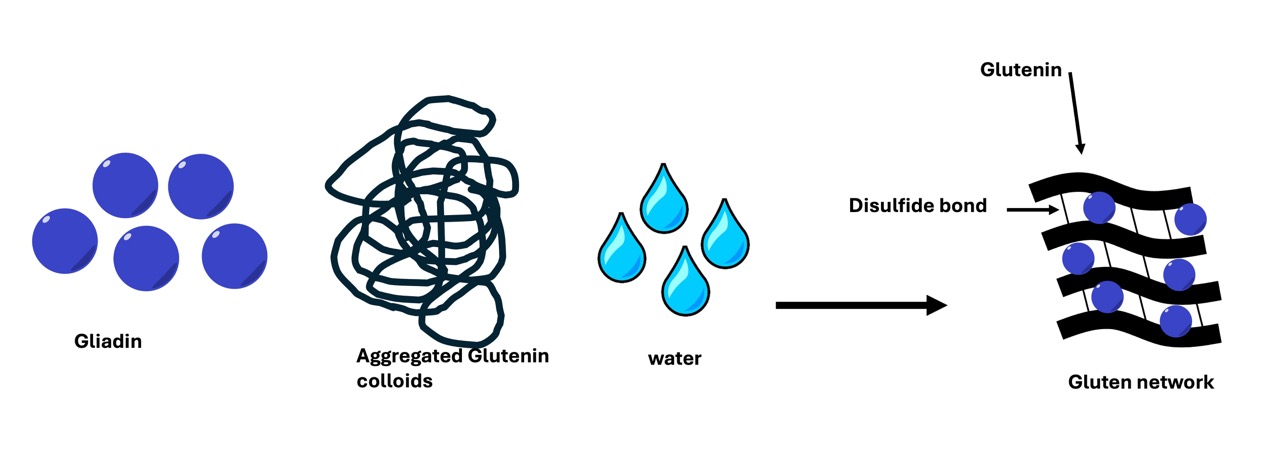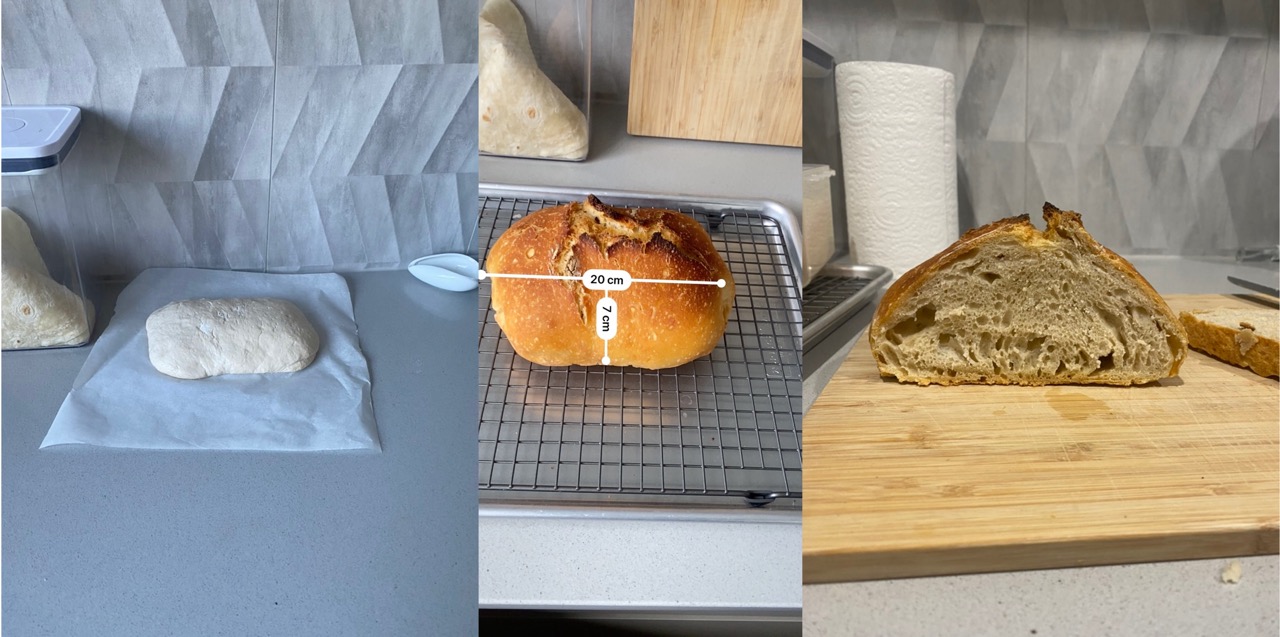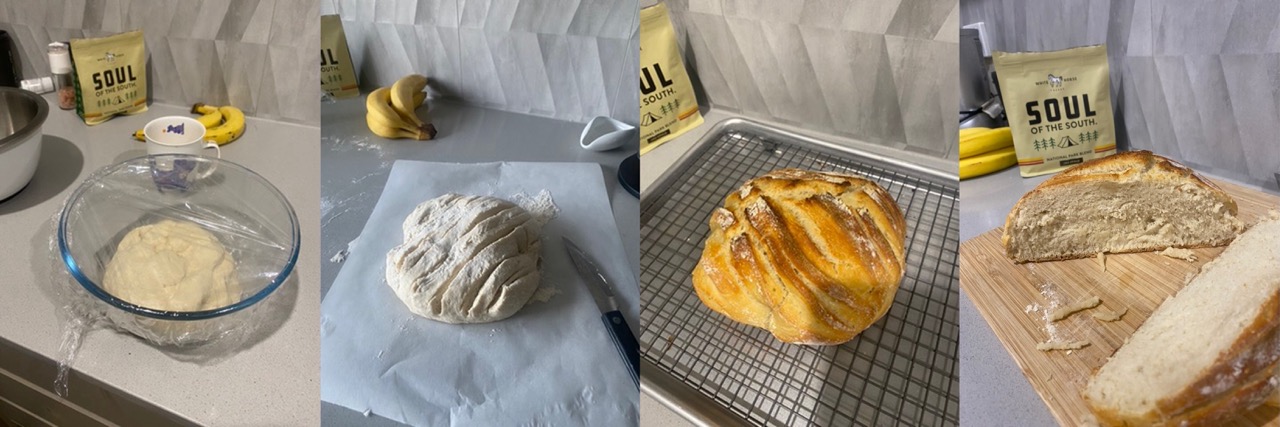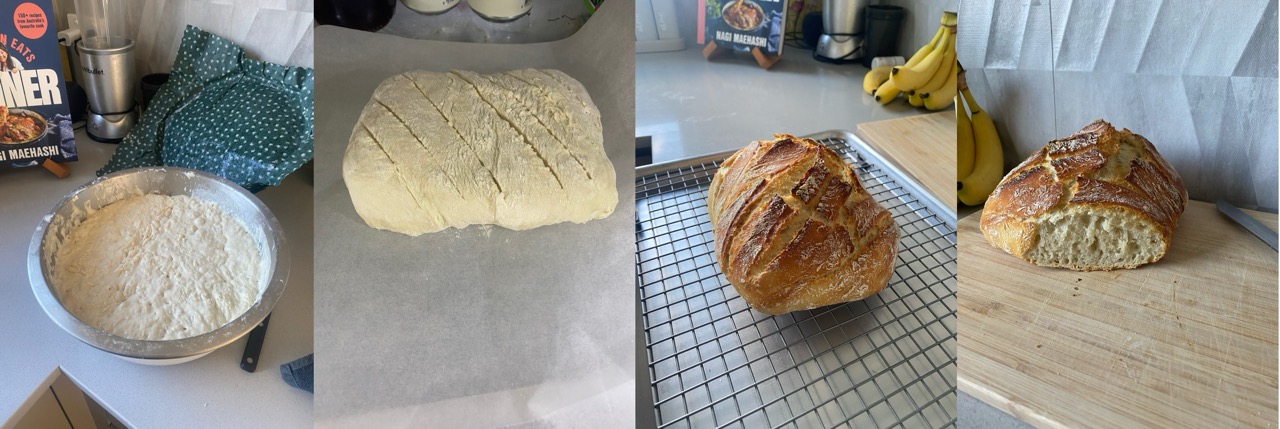Exploration of bread making
What I will cover in this post?
In this post, I will talk briefly about the science of bread, go through the optimisation of a bread recipe, testing several parameters including yeast content, hydration and the impact of freezing the dough before cooking. I will end this post by investigating wheat-based composites (basically mixtures of various wheat and non-wheat based flours).
A bit of science behind bread
9.5.2024
Flour contains proteins glutenin and gliadin, which are hydrophobic (water-hating) peptides. In the presence of water, they will self-assemble to form gluten (Fig 1), which is a result of the molecule preventing the hydrophobic regions from interacting with water. Prior to the addition of water, glutenin exists as a colloid. Upon addition of water to the flour, the chains are allowed to stretch, seperate, and form new disulfide linkages. These disulfide linkages create a network of glutenin polymer that produces the strength and elasticity of bread dough. At the same time, the smaller gliadin proteins will disperse through the glutenin polymer network, which allows the bread to "rise". It is the constituent that facilitates formation of the gluten network. Due to it's self-assembling properties (as it is highly hydrophobic), it will associate into spherical particles and absorb other nutrients such as vitamin E. Thus, the quality of the gluten network that forms is dependent on the type of flour that is used.
 |
|---|
| Fig 1. Schematic of gluten formation |
Mixing and kneading of the flour/water mixture encourages the gluten network to further develop. During this process, carbon dioxide is incorporated, producing a more porous dough once it is baked. Yet, we dont want the gluten networks to be so strong that they become chewy and tough. This is the reason that people turn to a "no-knead" method. Sometimes, a high water content is enough to facilitate formation of strong gluten networks.
Yet, there is one more ingredient that is required to create the gluten network... and that is salt. As mentioned in the "salting-out" post, salt helps to decrease the water content. In this instance, salt will remove water from the protein/polymer network to increase the strength and elasicity.
Making the initial loaf
The initial recipe that I started with came from Nagi: RecipeTinEats. The ingredients required were:
450 g flour
2 tsp yeast
2 tsp salt
375 mL of warm watern (~40 °C)
First, I started off with a "no kneading" approach to bread making. I was unsure of the measurements for the yeast. I had the large container of active yeast as well as the packets. I initially used the packets, and with a quick google search I saw that 7 g was an equivalent of 2 tsp of yeast. Therefore, in my first attempt to make this bread, I activated one packet of the yeast in warm water. The bread was left for a few hours in a warm-ish environment to rise, and then it was moulded into a round ball and baked using the dutch oven.
After baking, the bread was very tough to cut and very dense, but it was still quite tasty and full of flavour. These bread flavours arise from fermentation. The high density is possibly attributed to a low water content. Thus, for the subsequent loaves, I went for weighing out the ingredients using a scale instead of the "cups" measurement as a scale is more accurate.
A few days later, I used the recommended amount of yeast (2 tsp), weighed out the flour (450 g to be exact) and the water. I saw that the dough was still a bit "doughy", so I added an extra 20 mL of water to the batch (395 mL in total). It was too sticky to be able to knead (Fig 2, img1), yet it felt very soft and after allowing it to rise for several hours, I baked it using the dutch oven. NOTE: I was sure that it had risen well, when the dough (before baking) was very bubbly on the surface and small movements of the bowl containing the dough resulted in a "jiggling" of the dough surface. This time, it rose more than the previous batch (likely due to the extra yeast) and was less dense than the last batch (owing to the excess water added).
 |
|---|
| Fig 2. Batch 2: (img 1) sticky dough, (img 2) moulded dough for baking, (img 3) final product. |
Without a job at this point, I wanted to bake more and change the conditions to geet the best loaf. I wondered what is the impact of leaving the dough to sit for longer? What is the impact of kneading? Surely I can google this, but I wanted to experience the feeling and taste differences. Therefore, the next batch that I made, was using the same contents as above only, I allowed the dough to sit for 3 hours at room temperature, then 2 days in the fridge (covered). The day before cooking, I pulled out the dough, moulded it into a ball and allowed it to sit covered in plastic wrap in the fridge overnight. When I baked this loaf, it rose slightly more than the last batch, and was also more porous (Fig 3). From what I understand, it seems that when you put the dough in the fridge, fermentation is slowed down to allow the development of more complex flavours.
Optimising a few conditions
 |
|---|
| Fig 3. Batch 3: (img 1) moulded dough for baking, (img 2) final product and (img 3) a photo of the sliced bread, observing the porosity of the loaf. |
15.5.2024
The next parameter that I wanted to test is the impact of kneading on the dough. Therefore, a dough was prepared as previous, however, it was kneaded for 5 minutes of before allowing the dough to rise. Due to the better properties of the previous batch of bread, the dough was immediately placed in the fridge, in a covered bowel. The dough was left for close to 22 hours in the fridge. The dough appeared to have similar textures as the previous batch, however, was less soft upon touching it.
The dough was moulded and scored (using tips that I got from vegpatchkitchen) and baked from it's cold state. The idea behind scoring is that it allows the gases to uniformly escape, making bread the rise more uniform, instead of having that weird bubble in the middle of the loaf (as seen in img 2 of Fig 3).
While the final bread loaf in Fig 4 (img 3) appears to be more uniform, without the ugly bubble in the middle, it was less porous than batch 3 (Fig 3). This was attributed to the small additions of flour that I added in order to knead the bread. As small amounts of excess flour decreases the water content, the bread ultimately became more dense. I thought this bread was the tastiest and best looking so far.
 |
|---|
| Fig 4. Batch 4: (img 1) dough after kneading and ready to be placed in the frige, (img 2) moulded dough for baking, (img 3) final product and (img 4) a photo of the sliced bread, observing the porosity of the loaf. |
20.5.2024
This time, I doubled the batch size using the following ingredients:
900 g bread flour
656 g warm water (~ 40°C)
4 tsp salt
4 tsp of yeast
In this batch, the process was as follows. First, 4 tsp of dried yeast was added to 2 cups of warm water (equivalent to 427 g of water). The yeast was allowed to grow for 5 minutes and then added to the flour/salt mixture. The mixture was combined with a wooden spoon. As it appeared to be very flaky and floury, an extra 229 g of water was added. It appeared to be very slicky and slimy. It was too sticky to be kneaded, or even handled. This large batch was left in the mixing bowl, covered and put straight into the fridge for 22 hours.
The oven was preheated to 220°C and the dutch oven was preheated for 30 minutes. During this time, half of the mixture was taken from the large mixing bowl, moulded and scored and put back in the fridge (covered) until it was ready to bake it. The dough (on the baking paper) was gently placed into the dutch oven and baked for 30 mins with the lid on, and a further 10 mins with the lid off.
The bread was probably the best that I have made so far (I know I say this everytime... but is true). The defining features were the high porosity caused by the high water content, the uniform growth in the dough due to scoring of the loaf and the softness of the inside!
 |
|---|
| Fig 5. Batch 5. (img 1) risen dough, (img 2) scored dough, (img 3) baked bread out of the oven and (img 4) image of the face of the bread, showing a higher level of porosity. |
The second half of the mixture was left in the fridge for 2 more days. When I removed it from the fridge (22.5.24), the dough revealed bubbles which is indicative of gas being released. It was very sticky and very difficuit to pick up. I managed to mould it into a ball, with the aid of a small amount of flour. The dough was then wrapped in plastic wrap and placed in the freezer, where it sits until I am ready to bake again. Unfortunately due to my new working commitments, I get less time to bake! I will probably bake this loaf next week. Stay tuned!
30.5.24
Yesterday morning, I took the bread dough out of the freezer and placed it ontop of a plastic board, with the plastic wrap still covering it. I allowed it to sit in the fridge while it defrosted. The appearance was no different to when I put it in the freezer, however, it seemed to have less structural integrity (i.e. everytime I tried to mould it into a ball, overtime it would loss the shape). At 4.30pm, I begun preparing the oven to bake the dough. I popped it in for another half an hour bake, followed by 15 minutes without the lid.
When I pulled it out of the oven, it had a very large circumference which is consistent with the dough losing its shape. It rose a bit, but was not as inflated as previous. I suspect that some of the yeast died when it was frozen and to compensate for this, I shouldve added extra yeast to the batch. The bread was hard on the outside and soft on the inside, just like I like it. It was very porous and tasted good. I think this bread was great overall.
 |
|---|
| Fig 6. Batch 6: after the dough was frozen for 1 week, it was defrosted for 2 days in the fridge and then baked as usual. |
Making dough with the intention of freezing it...
1.6.2024
In preparation of a new dough, I used the following ingredients:
3 tsp yeast
1.5 cups of water + extra 48 g
1 pinch sugar
2 tsp salt
In this recipe, I used extra yeast as I intend to freeze the bread. In the last batch, the bread was really flat and seemed to keep losing it's shape. I attributed the poor shape to yeast dying during the freezing process. This enticed me to use more yeast this time, as I plan to freeze it.
Method To the yeast, add the warm water and a pinch of sugar. Wait 5-10 minutes for the yeast to foam (I love this part! It's like I am controlling my own little world). Add all dry ingredients to a bowl. Mix around and add the water/yeast mixture. Stir through. (Note: the mixture will be very wet. That is great. The more wet or sticky it is, the more porous it will be! Although I'm not sure how freezing will affect this though) and cover for 3 hours. (Note: I put my dough in the microwave, seems to be a warm spot).
After 3 hours, I pulled the dough out of the bowl, a lightly covered with flour, being careful not to press it (i.e. knead) too much. Next, I placed it in a bread bag, allowing a little bit of air in and room for the dough to still grow and then put into the freezer where it will sit for a few days. I plan to bake it sometime next week.
14.6.2024
On Tuesday 11.6.24, I pulled the dough out of the freezer and let it defrost in the fridge for 48 hours. On Thursday 13.6.24, when I arrived home from work, I moulded the bread (using some new bread moulders that I got last week) and baked in a preheated dutch oven. The bread was very tasty, with an even amount of pores. It rose a significant amount, indicating that the yeast was still active. The bread remained soft and fresh tasting for 3 days. I will definitely use this freezing method from now on.
The next task that I will undertake is crafting sourdough bread. I will begin with making a sourdough startup.
Incorporating Soy Flour
22.6.24
I was in the process of growing my sourdough starter, when I had an urge to bake more bread. This post is exhausted with the optimisation of bread, which I did not want to add to as it would get repetitive overtime. But this loaf was a little different.
On Thursday evening (20/6/24), I started to foam the yeast in warm water, and weigh out all the ingredients, when I found that we had no flour left. I used 300 g of plain flour. Then I scummaged the cupboard for anything that we may have and I found soy and coconut flour. After doing a quick search online, I found that people often add soy flour to their recipe to create softer bread. The highest % of soy flour incorporated was 10%. Therefore, I changed the recipe and used soy flour with plain flour. In my recipe, I used 16% of soy flour.
Ingredients:
50 g soy flour
295 g water
2 tsp yeast
1 tsp salt
a little flour for working up the dough
Steps:
- As usual, the yeast was grown in the warm water until it foamed (5 mins).
- Dry ingredients were combined
- Everything was mixed with a wooden spoon. The dough was very sticky and hydrated!
- The mixing bowl was covered and left and placed in the fridge for 36 hours. (note: by putting it in the fridge it slows the fermentation process. I think it was perfect at about 24 hours.)
- The dutch oven was preheated to 220 °C for 30 minutes
- The dough was taken from the fridge and folded a few times (with a little bit of spared flour for working). I believe this is a crucial step to ensure that the bread is porous but not too porous.
- The dough was placed in the dutch oven (using baking paper to transfer) and cooked for 30 minutes with the lid on, then 10 minutes with the lid off.
- The bread was allowed to cool for 10 minutes before we had it for breakfast! 😊
The bread was so soft! Unlike the other loaves that I made, this one was very easy to cut through. It was so soft in the mouth and had a different flavour to it. I'm not sure if the flavour was because there was a lower flour to yeast ratio, or due to the Soy flour, but it was definitely tasty and slightly sweeter than usual. It should also be noted that previous studies with soy flour have indicated that 10% incorporation is best for the texture and flavour of bread.
 |
|---|
| Img caption: Bread made with 16% soy flour |
As you can see from the images, the crumb of soy flour is slightly browner than previous loaves, with the crust being more golden. Soy bean itself is hydrophillic (water-loving) compared to wheat-flour which is water-hating. In bread recipes using 100% wheat flour, the hydrophobic associations (forms of non-covalent bonds, or interactions between molecules) between the gluten network make the bread quite tough. On the other hand, as soy flour is hydrophillic, it is more effective at absorbing water, which means that by incorporating soy flour into the dough, you will retain a higher level of water during the baking process. The proteins in soy will interact with water, and as the water evaporates, the bonds are less tough and therefore the bread will be softer.
References
- Cho, I.H. and D.G. Peterson, Chemistry of bread aroma: A review. Food Science and Biotechnology, 2010. 19(3): p. 575-582.
- Sha, X., et al., The prolamins, fro structure, property, to the function in encapsulation and delivery of bioactive compounds. Food Hydrocolloids, 2024. 149: p. 109508.
- Taghdir M, Mazloomi SM, Honar N, Sepandi M, Ashourpour M, Salehi M. Effect of soy flour on nutritional, physicochemical, and sensory characteristics of gluten-free bread. Food Sci Nutr. 2017; 5: 439–445. https://doi.org/10.1002/fsn3.411